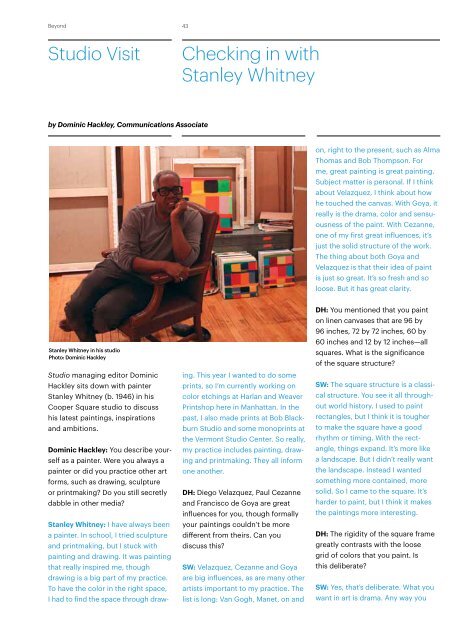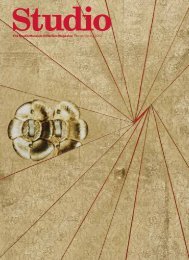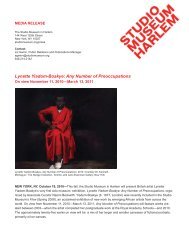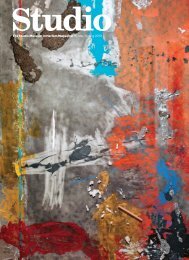Summer/Fall 2012 Download PDF - The Studio Museum in Harlem
Summer/Fall 2012 Download PDF - The Studio Museum in Harlem
Summer/Fall 2012 Download PDF - The Studio Museum in Harlem
You also want an ePaper? Increase the reach of your titles
YUMPU automatically turns print PDFs into web optimized ePapers that Google loves.
Beyond43<strong>Studio</strong> VisitCheck<strong>in</strong>g <strong>in</strong> withStanley Whitneyby Dom<strong>in</strong>ic Hackley, Communications Associateon, right to the present, such as AlmaThomas and Bob Thompson. Forme, great pa<strong>in</strong>t<strong>in</strong>g is great pa<strong>in</strong>t<strong>in</strong>g.Subject matter is personal. If I th<strong>in</strong>kabout Velazquez, I th<strong>in</strong>k about howhe touched the canvas. With Goya, itreally is the drama, color and sensuousnessof the pa<strong>in</strong>t. With Cezanne,one of my first great <strong>in</strong>fluences, it’sjust the solid structure of the work.<strong>The</strong> th<strong>in</strong>g about both Goya andVelazquez is that their idea of pa<strong>in</strong>tis just so great. It’s so fresh and soloose. But it has great clarity.Stanley Whitney <strong>in</strong> his studioPhoto: Dom<strong>in</strong>ic Hackley<strong>Studio</strong> manag<strong>in</strong>g editor Dom<strong>in</strong>icHackley sits down with pa<strong>in</strong>terStanley Whitney (b. 1946) <strong>in</strong> hisCooper Square studio to discusshis latest pa<strong>in</strong>t<strong>in</strong>gs, <strong>in</strong>spirationsand ambitions.Dom<strong>in</strong>ic Hackley: You describe yourselfas a pa<strong>in</strong>ter. Were you always apa<strong>in</strong>ter or did you practice other artforms, such as draw<strong>in</strong>g, sculptureor pr<strong>in</strong>tmak<strong>in</strong>g? Do you still secretlydabble <strong>in</strong> other media?Stanley Whitney: I have always beena pa<strong>in</strong>ter. In school, I tried sculptureand pr<strong>in</strong>tmak<strong>in</strong>g, but I stuck withpa<strong>in</strong>t<strong>in</strong>g and draw<strong>in</strong>g. It was pa<strong>in</strong>t<strong>in</strong>gthat really <strong>in</strong>spired me, thoughdraw<strong>in</strong>g is a big part of my practice.To have the color <strong>in</strong> the right space,I had to f<strong>in</strong>d the space through draw<strong>in</strong>g.This year I wanted to do somepr<strong>in</strong>ts, so I’m currently work<strong>in</strong>g oncolor etch<strong>in</strong>gs at Harlan and WeaverPr<strong>in</strong>tshop here <strong>in</strong> Manhattan. In thepast, I also made pr<strong>in</strong>ts at Bob Blackburn<strong>Studio</strong> and some monopr<strong>in</strong>ts atthe Vermont <strong>Studio</strong> Center. So really,my practice <strong>in</strong>cludes pa<strong>in</strong>t<strong>in</strong>g, draw<strong>in</strong>gand pr<strong>in</strong>tmak<strong>in</strong>g. <strong>The</strong>y all <strong>in</strong>formone another.DH: Diego Velazquez, Paul Cezanneand Francisco de Goya are great<strong>in</strong>fluences for you, though formallyyour pa<strong>in</strong>t<strong>in</strong>gs couldn’t be moredifferent from theirs. Can youdiscuss this?SW: Velazquez, Cezanne and Goyaare big <strong>in</strong>fluences, as are many otherartists important to my practice. <strong>The</strong>list is long: Van Gogh, Manet, on andDH: You mentioned that you pa<strong>in</strong>ton l<strong>in</strong>en canvases that are 96 by96 <strong>in</strong>ches, 72 by 72 <strong>in</strong>ches, 60 by60 <strong>in</strong>ches and 12 by 12 <strong>in</strong>ches—allsquares. What is the significanceof the square structure?SW: <strong>The</strong> square structure is a classicalstructure. You see it all throughoutworld history. I used to pa<strong>in</strong>trectangles, but I th<strong>in</strong>k it is tougherto make the square have a goodrhythm or tim<strong>in</strong>g. With the rectangle,th<strong>in</strong>gs expand. It’s more likea landscape. But I didn’t really wantthe landscape. Instead I wantedsometh<strong>in</strong>g more conta<strong>in</strong>ed, moresolid. So I came to the square. It’sharder to pa<strong>in</strong>t, but I th<strong>in</strong>k it makesthe pa<strong>in</strong>t<strong>in</strong>gs more <strong>in</strong>terest<strong>in</strong>g.DH: <strong>The</strong> rigidity of the square framegreatly contrasts with the loosegrid of colors that you pa<strong>in</strong>t. Isthis deliberate?SW: Yes, that’s deliberate. What youwant <strong>in</strong> art is drama. Any way you






